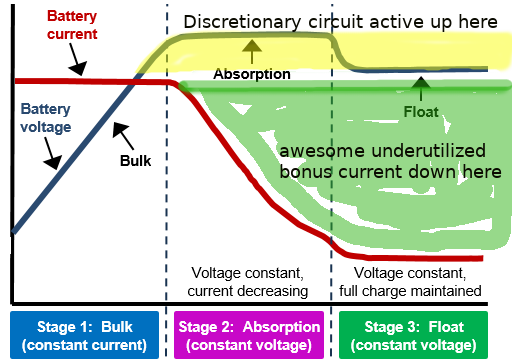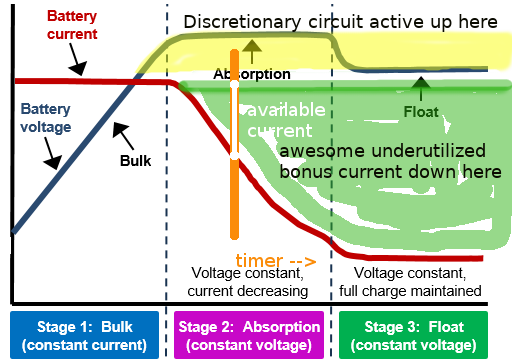Table of Contents
opportunity loads
 Solar power installations are generally designed as if the load[s] will be steady around the clock. This can lead new folk into buying too much battery.
Solar power installations are generally designed as if the load[s] will be steady around the clock. This can lead new folk into buying too much battery.
In practice, actual loads may be heavier in the daytime (as when working with power tools) or at night (as when watching movies or running a forced-air furnace).
If loads are applied attentively (or automatically!) one can run electrical loads that do not affect the battery bank's State of Charge at all. Additionally, consuming loads at the right time can also increase the health and longevity of lead batteries.1)
how much surplus current is there?
It is common for Lead-Acid batteries to consume C/100 or C/200 amps to Float, meaning that during Float you will have at least 99% your panels' output2) available for loads.3)
During Absorption the charge current is tapering down as the battery accepts less; the more it tapers down the more is available for loads.4) At the very beginning of Absorption ~0% of “bonus” output is available. At the very end of Absorption 99%+ is available. Mid-way through Absorption5) ~49% of the panels' output is available for loads. See the image at the top of the page for an example of how current demand drops in Absorption.
There will generally be more “surplus” power available when using MPPT charge controllers v. PWM,6)7) though the difference is less dramatic during periods one would run opportunity loads (see below). Siphoning off power can actually help PWM controllers run cooler by reducing the ON-OFF switching activity that generates heat.
Overpaneled systems have even more excess power available.
when to run opportunity loads
The optimal time to run loads is when there is power available in excess of battery charging requirements. When done at the right time, the loads are effectively run off the panels rather than off the battery bank. This results in the bank having a higher state of charge both at sundown and morning.
With lead this means during Float, or in late Absorption when charge current acceptance has fallen enough that the system can run the loads and still maintain the Absorption voltage setpoint.
There is a little more wiggle room with LiFePO4; the loads can be run with no net negative effect on a Lithium system when
- the bank has reached the intended charge state; or
- any time the bank can be projected to reach the intended charge state by sundown while carrying the extra loads. In effect, lithium allows you to “borrow” against future charging without penalty.. Exception: Lithium setups with PWM solar charge controllers will make most power when bank voltage is highest. So waiting for Float or Absorption to run opportunity loads will mean the solar can make more Wh per day.
timing opportunity loads
The trickiest part of running opportunity loads is running them at the right time so battery charging is not affected.
manual model
You can start the loads manually (ie, start using the power when you have extra). This is error-prone but is free and requires no equipment (except your own memory).
charge controller
The most precise way to do it automatically is to use a charge controller that can act as a diversion controller. Charge controllers with this feature tend to be expensive, and tend to run in either solar or dump load mode. This may be preferable with lithium or other chemistries that do not require multistage charging.
Read the documentation and ask their techs questions before taking this $$$ approach.
Related:
- you can also build a Pi or similar that talks to the controller over its communication port/protocol and checks when the controller is in Float, and then triggers the diversion.
- some hobbyists are using AC7391 controllers to directly run dump loads w/out battery charging. Not necessarily a solution for vandwellers but may help our thinking.
diversion controller
The Victron BMV-700 battery monitor can act as a programmable relay controller8), turning loads off/on at a given state of charge.
LVD only
A free way to automate opportunity loading is to set the normal controller's LOAD or external Low Voltage Disconnect to shut off below Vfloat.
Since the LVD only knows voltage and Vabs > Vfloat this approach will
- correctly run the opportunity load in Float; we want this.
- inadvertently run the opportunity load in the latter part of Bulk stage. This scenario occurs when voltage is >= Vfloat but < Vabs; we probably don't want this. It's better than running the loads wide open any time the system is above 50% DoD but if a given system struggles to reach Absorption mode further tweaking is possible.
To run loads heavier than the rating of the LVD or LOAD output use a relay between the LVD and the load.
This setup looks like: [LVD or controller LOAD output] –> relay –> load
LVD + timer
 A 12v timer could give the system a chance to make some progress in Absorption before starting up opportunity loads. If mistimed or overly heavy loads applied, Absorption duration could be affected.
A 12v timer could give the system a chance to make some progress in Absorption before starting up opportunity loads. If mistimed or overly heavy loads applied, Absorption duration could be affected.
In this approach the LVD is set just below Vfloat as above, but activation of the loads is delayed by some amount of time. Observation of the system during charging will suggest how long it normally takes takes charging amperage to drop off (ie, when the system has surplus current).
Suggested delay for conservative opportunity loading == the time from [passing Vlvr setpoint during Bulk] to [completed charging].9). This delay might be 2-5hours.
Suggested delay for aggressive opportunity loading == the time from [passing Vlvr setpoint during Bulk] to [far enough into Absorption that enough current is available to power intended loads]. This delay might be 30-60 minutes, depending on the charging rate.
This setup looks like: [LVD or controller LOAD output] –> timer –> relay –> load
LVD + timer - eternal Absorption
This setup avoids timer juggling/estimation and does not affect Absorption charging.The downside is the opportunity circuit engages much later.
- observe how long Absorption actually takes to drop to endAmps on your system
- set the LVD to just under Vabs, set the timer to the Absorption duration
Similar to the above, this setup looks like: [LVD or controller LOAD output] –> timer –> relay –> load
uses for opportunity loads
For best results the opportunity load should be sized to the excess power. Otherwise the system could go into dump/recharge cycling.
- heating water
- laptop and phone charging

